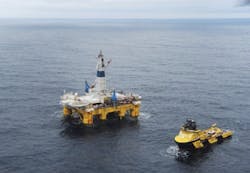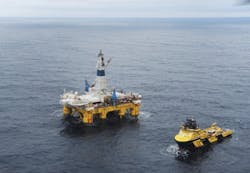Assessing topsides requirements for direct electric heating system
Rajan Batra
Chevron International Exploration & Production
Direct electric heating systems (DEH) are a relatively novel technology, and there are currently more than 150 km (about 93 mi) of pipelines installed or under design that are using this technology. The DEH system predominantly benefits deepwater and isolated flowline offshore production systems, where it is often difficult to use established and conventional methods for flow assurance, wax, hydrate, or plug removal.
The DEH system can be deployed in many ways. In one particular arrangement, the single phase alternating current flows through the piggyback cable and returns through the metallic wall of the pipeline and through the seawater. The resistance created by the steel pipe and electromagnetic field from the piggyback cable generates power losses in the form of heat, thus heating the flow pipeline. The metallic flow pipeline acts as a conductor in a single phase/alternating current electrical circuit arrangement, along with the DEH cable strapped to the flow pipeline. Topsides electrical power is generally fed to the flow pipeline via the DEH piggyback cable.
In this arrangement, the hydrocarbon flow pipeline is not insulated electrically in the sea water. While the flow pipeline is able to get in touch with sea water, the DEH current will flow across the pipeline as well as to the seawater.
The goal here is to discuss the requirement of different topsides utilities and other topside considerations for the DEH system design. The primary utilities which might be required for a typical DEH system include cooling water, high voltage power, low voltage power, uninterrupted power supply, air, and other inputs.
Power requirements
DEH power is generally fed from the topsides facility platform. Topsides facility power generation must be able to handle the step loads due to DEH operations in different modes. The DEH topsides equipment must not create resonance or harmonics that could damage the DEH system or create topsides facility power system stability issues. Various electrical studies should be conducted to verify the suitability of topside electrical system.
Steady-state load flow and motor starting studies should be conducted to ascertain the adequacy of the steady state system function, and determine tolerable voltage drops during start of the DEH loads. Studies should include addition of any DEH low-voltage motor control centers; a high-voltage feeder supplying power for a DEH system; and several other small loads required for auxiliaries like HVAC for DEH container; cooling system for cooling DEH equipment (if required); lighting, etc. The load flow and motor starting study results should specify whether the production platform electrical system is sufficient to supply electrical power for the DEH loads during different modes of operation.
The load flow studies should be conducted mainly to authenticate the capability of the continuous ratings of main electrical system, and to ensure steady state function of the electrical system with tolerable voltage profile for the a range of operating cases (i.e., different DEH operating cases may require different powers for different levels of heating, based on the DEH purpose). Further, static motor starting studies should be performed to find out the electrical system load flow and voltage profile at the time of motor starting. Study establishes the greatest voltage drop on the topsides electrical system during the starting of the large motors.
Cable insulation breakdown or moisture/water introduction into an electrical equipment or system can cause short circuit by allowing current to flow along a pathway other than the one planned. A short circuit is an unintentional and unplanned path of low impedance which allows an unusually high magnitude of current. This unintentional and unplanned current will be several times more than the regular and intended circuit current. In this scenario, the short circuit must be opened and the short circuit current must be interrupted or stopped to avoid widespread and extensive damage to the electrical system and equipment. Hence protective devices (fuses, circuit breakers, or other protection devices), which are rated for correct short circuit currents, should be used to interrupt the short circuit currents. Therefore it is vital to conduct a short circuit analysis to calculate the potential short circuit current that is expected during short circuit conditions.
A relay coordination study determines the proper, appropriate and correct selection and settings of the protective devices to ensure that the circuit interrupter nearest to the electrical faults acts before other devices. This, in turn, increases the reliability and safety of the electrical system, and helps reduce costly and unnecessary downtime. So, basically, the intent is that downstream protective devices (fuses, circuit breakers, or other protection devices) should activate before upstream protective devices. This will trip only the required system affected by a fault/disturbance. For example, if there is fault at a DEH system, then DEH feeder breakers should trip before the main. Further, a detailed power system analysis should verify how the topside DEH system interacts with harmonic currents sources and the dynamic characteristics of the topsides electrical system.
Power supply
The uninterruptable topsides power supplies (UPS) should power the DEH control and protection system, emergency egress lighting near DEH system, and any additional fire and gas equipment and emergency shutdown system. A new UPS system on the topsides should be designed to power the required DEH systems, or the existing UPS system should have enough spare capacity to power the required DEH systems.
The battery system should be sized to provide power to DEH control and protection system, fire and gas equipment and emergency lighting, etc., for at least four hours. This capability should exist throughout the expected life of the batteries. Further, DEH HMI (Human Machine Interface) should also be connected to UPS power supply to maintain a reliable power source, since DEH HMI is critical for safe operation and maintenance of DEH equipment on the topsides.
Power cable
DEH topsides equipment location and layout design should require close examination of DEH power cable routing and termination, from the topside feeder to the DEH transformer; to the DEH reactor to the DEH capacitors; and then to the DEH topsides junction box. Minimum cable bending radius requirement should be investigated, and cable routing design and DEH equipment layout should be done accordingly.
Hazardous areas
Electrical hazardous area classification for the topsides should follow the American Petroleum Institute (API) Recommended Practice RP-500 and/or as per other relevant applicable guidelines/codes. The DEH system with electrical equipment in the topsides facility located in an electrically hazardous classified area should be constructed in accordance with hazardous area classification. All new fire and gas detection devices should meet the electrically hazardous area classification requirements.
Other system requirements
Some other key components and systems requirements for a DEH system are described below.
Cooling system requirements. The diagram shows the major components typical of a topside DEH system. These include power transformer, reactor, capacitor bank, and topside DEH junction box. The transformer’s loading capacity is fairly decided by its ability to dissipate heat.
A cooling system increases the load capacity of a transformer and reactor by improving its ability to dissipate the heat generated by electric current. Water cooling enables effective and compact transfer of heat losses from the electrical premises. DEH components (DEH transformer and DEH reactor) may use water-cooled arrangements for cooling this DEH equipment. Required cooling water flow, pressure, and cooling water specifications depend on the transformer and reactor engineering design and facility ambient conditions.
Cooling water can be supplied either from the topsides facility’s water cooling system or from the DEH cooling water package. The latter might include water pumps, water coolers, and control panel, among other equipment. Providing cooling water from topsides facility may be more economical, and might also help to avoid using the extra space and adding extra weight for the DEH cooling water package.
Further, the DEH cooling water package would be an extra system to operate and maintain, and may increase the DEH’s opex and reduce system availability. Hence, it should be preferred to use the topsides facility cooling water system, if feasible. Normally, the cooling water temperature is 25 to 35 °C, depending on site conditions.The temperature rise introduced from the transformer coolers is typically around 5 °C, and depends on the size and design of transformers.
DEH equipment cooled by water should be tested periodically to make sure it operates properly, and is not leaking. Leaks can be checked by raising the pressure within the cooling system. Other equipment linked to a water-cooled system can be tested at the same time, such as water pump and pressure gauges. Also, the topsides water source should be tested for sufficient flow and pressure.
Equipment ventilation requirements. DEH layout on the topsides should consider any ventilation requirements for its equipment. Some equipment needs more ventilation than others, like dry-type transformers. If the DEH system uses dry-type transformers, the area in which the transformer is to be installed should have adequate and proper ventilation. This ventilation should be checked prior to installation to make sure it is adequate. Additionally, the transformer’s radiator vents should be kept clear of obstructions that could impede heat dissipation. So the layout of the DEH transformer and other equipment should consider the ventilation requirements of individual DEH components.
Maintenance and access requirements. DEH equipment layout and arrangement should allow safe and efficient access for operations and maintenance activities. Design guidelines usually provide minimum safety requirements, including normal and emergency operating conditions.
Air requirements. The DEH container might require maintaining positive pressure of clean air inside an enclosure with respect to an external atmosphere; so that the external hazardous atmosphere cannot come in contact with ignition sources inside the DEH container. This air for maintaining positive pressure inside the DEH container can be supplied from topsides air compressors, or from dedicated air equipment like air fans. Selection of the source of air supply, flow, and pressure should be made based on factors such as the size of container; availability of atmospheric clean air; and space availability at the topsides facility for dedicated air equipment.
Weight & CoG limitations. Similarly, another important consideration are the weight and center of gravity (CoG) limitations on the offshore facility. The weight is based on equipment weights from the DEH equipment (i.e., container, transformer, reactor, capacitor, etc.); utilities piping (i.e., cooling water, drains); instrumentation (i.e. sensors, fire and gas detectors); electrical (i.e. switchgear, MCC, cables, trays, earthing, etc.); and structural weights (i.e., platform deck for DEH).
Operator training. Operations and maintenance personnel should be well trained and provided with written procedures for the operations of the DEH system. Operational philosophy should be developed based on inputs from all stakeholders, including the DEH supplier, topsides facility system supplier, flow assurance service providers, subsea equipment suppliers, and so on. Operator training station (OTS) should be designed to replicate the complete facility, including the DEH system. OTS can help train operators and other personnel on the DEH system, and increase the effectiveness of their response to an abnormal or emergency condition.
The author
Rajan Batra is an Instrumentation & Electrical Lead, for Major Capital Projects at Chevron International Exploration & Production in Houston.
Offshore Articles Archives
View Oil and Gas Articles on PennEnergy.com

